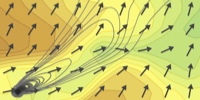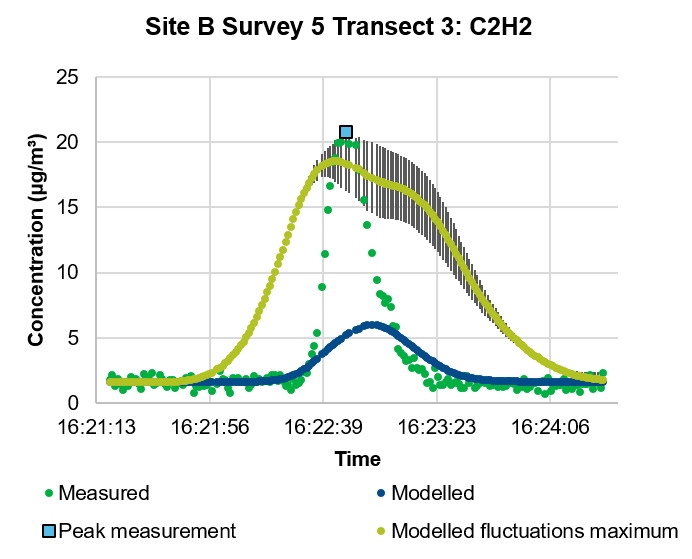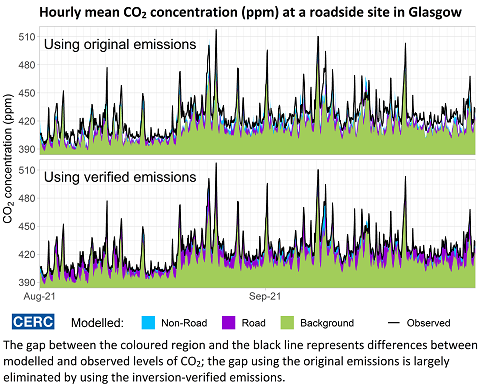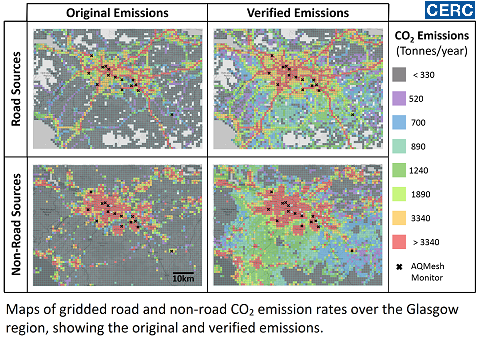
- Overview
- Atmospheric dispersion
- Atmospheric chemistry
- Urban air quality
- Regional to local air quality modelling
- Vehicles and roads
- Aviation
- Emissions
- Urban heat island
- Atmospheric boundary layer
- Wind energy
- Hazardous releases
- Inverse dispersion modelling
- Net Zero
- Model evaluation
- Smart cities
- Web platforms
- Older projects
- CERC co-author publications
- CERC software publications
- Presentations
Inverse dispersion modelling
Quick links: Estimating methane emissions Verification of CO2 emissions
Inverse dispersion modelling methods allow the estimation of unknown emission rates from concentration data. CERC have developed an inverse dispersion modelling approach in which a Bayesian inversion technique is applied to atmospheric dispersion model results and concentration measurements from monitoring sites, to improve estimations of pollutant emission rates. CERC have used this technique to develop a new software tool, ADMS-EIT, which can estimate emissions for a wide range of scenarios, from single emission sources to a whole urban area. ADMS-EIT can be used to refine emission rates where a good initial estimate is available, or to provide an estimate of emissions where little information is known.
Estimating methane emissions
The UK Environment Agency commissioned CERC and AQC to investigate inverse dispersion modelling methods which could be applied to fugitive (uncontrolled) sources of methane. Improving estimates of methane emissions from sources such as landfill sites is important for quantifying greenhouse gas impacts.
The report from this project includes a literature review of different inverse dispersion modelling methods; an assessment of the applicability of inverse dispersion modelling methods to different EA-regulated facilities; a study testing four inverse dispersion modelling methods with measurements from three landfill sites; and recommendations for future use of inverse dispersion modelling.

For this project CERC developed a new ‘modified Bayesian’ inverse modelling technique, due to the short timescale of the plume transect measurements. Measurements at 1 second intervals capture the instantaneous rather than ensemble plume. The concentration fluctuations module in ADMS was used to represent the short-term distribution of concentrations, with inverse modelling applied to the peak modelled and measured concentrations only.
The image shows an example of transect measurements of acetylene (C2H2) tracer gas. The 1 second measured data displays a narrow peak, while standard modelling (‘modelled’) predicts a wider plume with a lower peak concentration. The maximum model prediction of 1 second concentrations from the fluctuations module (‘modelled fluctuations maximum’, also showing standard deviation error bars) gives good agreement with the peak measurement. Methane measurements from the same transect were used in the inverse modelling study.
The study showed that the technique performs well and is a potentially viable approach to estimating emissions at landfills. The results suggest that one tracer gas dispersion survey combined with inverse dispersion modelling at other times of year could provide a good estimate of a landfill’s annual methane emissions.
Verification of CO2 emissions


Verification of CO2 emissions is essential to achieving Net Zero and “keeping 1.5 alive”. Researchers from CERC, Cambridge University, and ACOEM collaborated to verify CO2 emissions in Glasgow by combining measurements and ADMS-Urban model output. The study, using available traffic data and emissions factors, suggested that CO2 emissions from road traffic around Glasgow could be underestimated by up to 20%. These methods could be applied to verify the effectiveness of Net Zero policies.
15 AQMesh pods were co-located with Scottish Air Quality Network reference monitors at a number of sites, taking measurements of CO2 and other pollutants at 1-minute resolution. In addition, two LI-COR reference-grade instruments measured CO2 at 1-minute resolution. ADMS-Urban was applied to calculate hourly CO2 concentrations at the measurement sites for the period of the measurements using NAEI gridded emissions and DfT traffic flows, and allowing for the effects of street canyons. Road emissions within 2km of each monitoring site were modelled explicitly as road sources; other road emissions were modelled as 1km x 1km gridded emissions. Hourly background CO2 was obtained from hourly baselines of the 1-minute AQMesh measurements calculated by the University of Cambridge team.
CERC applied Bayesian based inversion techniques to combine hourly modelled CO2 concentrations with hourly AQMesh and LI-COR measurements. The technique allows for the differences in uncertainty between the low-cost sensors and the reference monitors, for the uncertainties of the emissions from each source and for correlations between source emissions. The differences between the original and inversion-verified emissions provide an indication of the accuracy of the original emissions inventory.
The project was funded by NERC and the Scottish Government.
